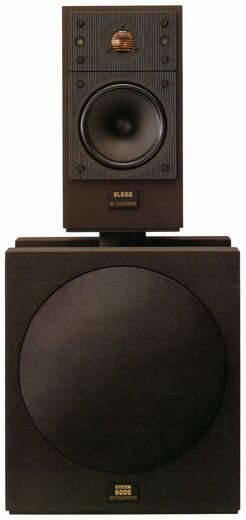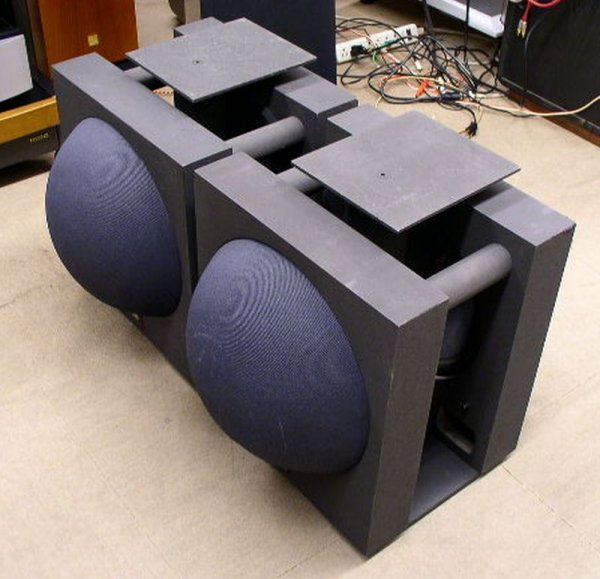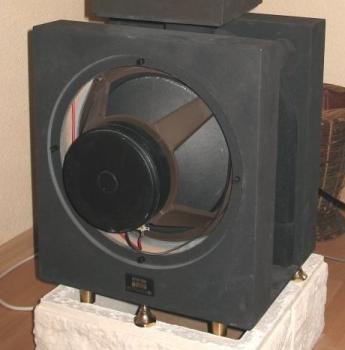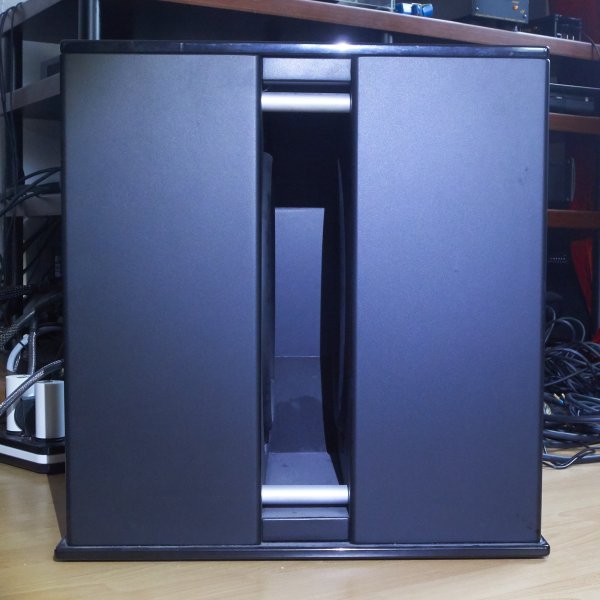Those subs have different drivers and class d amps, there is no comparison with Statement subs.I felt that putting on the balanced force subs ruined the tone of the CLX. I checked with an owner (Harlequin, who doesn't frequent the forum anymore) and he felt the same.
What is the most musical, fast and accurate subwoofer you have heard?
- Thread starter treitz3
- Start date
You are using an out of date browser. It may not display this or other websites correctly.
You should upgrade or use an alternative browser.
You should upgrade or use an alternative browser.
The Statement E2 uses 16 7,5 inch drivers in open baffle configuration from 200hz -50hz and the sub towers with16 12inch drivers from 50hz down, stat panels only play down to 200hz.
and you said you only had a little woofer... you are clearly a modest man MilanThe Statement E2 uses 16 7,5 inch drivers in open baffle configuration from 200hz -50hz and the sub towers with16 12inch drivers from 50hz down, stat panels only play down to 200hz.
12 inches is smallishand you said you only had a little woofer... you are clearly a modest man Milan
Mark Seaton
WBF Technical Expert (Speaker & Acoustics)
Those subs have different drivers and class d amps, there is no comparison with Statement subs.
Correct. The Statement E2 subs are a very different animal than the internally powered subs ML currently offers. Compared to many modern sub offerings, the pair of drivers in each module have similar displacement to a single 12" woofer. Asking less from each woofer and having a design that was always intended to use the stack of 4 makes for a nice advantage over having to account for use as just a single module as well as a set of 4-8 units.
I will say that along with a handful of other subwoofers, the Statement E2 bass towers were definitely a reference point I used for comparison for many years. Also for clarification, the subs are bi-polar in that both subs work together, but they radiate sound equally in all directions below 100Hz.
Thank you for the clarification Mark.Correct. The Statement E2 subs are a very different animal than the internally powered subs ML currently offers. Compared to many modern sub offerings, the pair of drivers in each module have similar displacement to a single 12" woofer. Asking less from each woofer and having a design that was always intended to use the stack of 4 makes for a nice advantage over having to account for use as just a single module as well as a set of 4-8 units.
I will say that along with a handful of other subwoofers, the Statement E2 bass towers were definitely a reference point I used for comparison for many years. Also for clarification, the subs are bi-polar in that both subs work together, but they radiate sound equally in all directions below 100Hz.
What does this even mean?
Never mind.
Peace
Mark Seaton
WBF Technical Expert (Speaker & Acoustics)
Thank you for the clarification Mark.
Happy to clarify, and it is fun to see something I helped deliver/set up >20 years ago still going strong. BTW, do you still use the originally supplied crossover with those? While everyone likes to get caught up in exotic parts, many might be surprised to know that Eminence Loudspeaker custom built those drivers for ML (the designer mentioned when I asked on a factory visit to hear the prototypes in Gayle Sanders's home). As usual, execution is everything.
My sub towers are the second pair i own. I mistakenly sold my first set of Statements when i moved back to Europe and did not have the room for them anymore. I came upon my second pair of subs from a ex Martin Logan distributer in Switzerland. He had sold the main towers without subs, they had been boxed up in a warehouse for 15 years and where missing crossover and one spike. Martin Logan sold me a spare spike, and i used different pro crossovers until i found a original one a couple of years later on ebay. ML actually redesigned the original crossover on the last production speakers, and i prefer using a Rane pro audio crossover on frequency’s under 100Hz to the subs. I run my MBL’s mains on the passive internal crossover without active manipulation, the same way MBL do in theirHappy to clarify, and it is fun to see something I helped deliver/set up >20 years ago still going strong. BTW, do you still use the originally supplied crossover with those? While everyone likes to get caught up in exotic parts, many might be surprised to know that Eminence Loudspeaker custom built those drivers for ML (the designer mentioned when I asked on a factory visit to hear the prototypes in Gayle Sanders's home). As usual, execution is everything.
X-treme speaker system. The internal 12 inch drivers in the MBL‘s are not active.
I really like the rythmik direct servo system but I actually prefere (if room placement permits) the open baffle versions made with gr research drivers and modded amps. I use 3x12" per side in H frame baffles and they easily blend with my multi channel horn system. They blend and sound better than the tapped horns, bass reflex boxes with dual TAD 1601b's and sealed arrays I have tried.
I liked them so much that I included them as bass system for my newly developed speaker system. 2 for each side, in H frames that play below the horn loaded planar ribbons. They once more proved they are very fast in starting and stopping. I hear and measure no problems that may happen in older servo feedback systems.
I liked them so much that I included them as bass system for my newly developed speaker system. 2 for each side, in H frames that play below the horn loaded planar ribbons. They once more proved they are very fast in starting and stopping. I hear and measure no problems that may happen in older servo feedback systems.
My sub quest began ca. 1979 when I acquired Magnepan MG-I's and decided they really needed some added bass. There were only a few around and that time, mainly AudioPro (long gone), M&K, and Velodyne. Velodyne had an interesting servo design but was way too expensive for a college kid, even one with dealer's accommodation (I was working as a tech in a couple of stereo stores). So I built my own version, using a 12" dual voice coil woofer from Infinity's IRS and a DIY crossover and servo circuit, and built a box to house the driver based on the usual Helmholtz equations (did not have speaker design SW back then). I used the second voice coil as the sensing circuit for the servo, an approach that was easier (and cheaper) for me to implement than Velodyne's approach back then, and with a few advantages like better control of thermal effects. The control box could drive a single amp or bridge a pair of channels; I used it with a Phase Linear 700 but switched to a bridged Hafler DH-200 I was not using at the time. It was better than most passive subs, and equal to or better than the Velodyne's we had on hand to compare (measured and listening tests).
Through the years I owned a number of other subs, mostly cheaper models from Mirage, Infinity (to match with my Alpha's, not the IRS2's I owned much earlier), BiC, a few others I've forgotten. Along the way I built a few other DIY models, mainly passive, for friends, experimenting with larger subs in (much) larger boxes as well as some arrays of smaller drivers (despite all the hype about "faster" the arrays did not work well for me). I did not own but built a few open-baffle subs for friends and customers, some servo, some not. They usually had higher distortion though the servo helped. For the record, a well-implemented passive sub was comparable to my servo design, but usually in a larger box and using a much larger (and more expensive) amplifier.
I took a hiatus, Life and Work happened, and finally returned to setting up my main system about ten years ago. My old sub's driver had been holed by a moving company so was no longer functional (they reimbursed the cost by the driver was unobtanium by then). Having funds for a new sub and zero time to build one again I auditioned a few. I heard a couple of B&W's and did not like them (they have come out with much improved designs since but I've not heard the new versions), JL, Paradigm, Velodyne, and one or two others I have forgotten. I did try a REL but did not care for it as it was configured (using high-level inputs from the main amp, not a configuration I care for). I heard about Rythmik, spoke some with Brian (who it turns out has a similar day job and similar servo circuit), and order a Rythmik sub . I was not able to do much in the way of listening tests since I did not have them all on hand, but I tried my best. I thought the little Rythmik as the equal of the 12" and 15" mid-level JL, Paradigm, and Velodyne models, mostly on par with their upper (and thus 3x~5x more expensive) models. I also decided that, in the perhaps $2k to $5k range of commercial offerings, subs had significantly improved from those early days. (Aside: I did not hear of Seaton until later, but would expect them to perform superbly as well). The HT revolution had clearly expanded the range and performance of subwoofers.
For myself, I stuck with Rythmik, buying a few more over the years, and quit auditioning others for lack of time and interest. My experience suggests there are many really good options these days, and a few clunkers, but with so much Internet chatter and more reviews (with measurements) it is easier than ever to find a good sub.
As an aside, the "speed" thing puzzled me, but I decided many years ago what really mattered was low distortion, even frequency response (which the room will destroy anyway), and sufficient cone (driver) control to ensure the sub "starts" and much more importantly "stops" quickly and cleanly. A sub that "rings" after the source (signal) has stopped will muddy the bass. While I chose servo for it's excellent performance in a small size, a good non-servo design can be equally as effective IME, just takes more care in integrating driver, amplifier, and box as well as consumer choice so the sub can provide the sound levels required without distortion. Since distortion occurs at harmonics of the fundamental, it is usually much easier to hear the distortion than he fundamental when we're talking subwoofer frequencies. This makes lesser subs sound "richer" or "fuller" but they are not "cleaner". A good sub is a revelation in how the deepest bass supports the overall sound without adding extra "boom" that is not there.
All IMO - Don
Through the years I owned a number of other subs, mostly cheaper models from Mirage, Infinity (to match with my Alpha's, not the IRS2's I owned much earlier), BiC, a few others I've forgotten. Along the way I built a few other DIY models, mainly passive, for friends, experimenting with larger subs in (much) larger boxes as well as some arrays of smaller drivers (despite all the hype about "faster" the arrays did not work well for me). I did not own but built a few open-baffle subs for friends and customers, some servo, some not. They usually had higher distortion though the servo helped. For the record, a well-implemented passive sub was comparable to my servo design, but usually in a larger box and using a much larger (and more expensive) amplifier.
I took a hiatus, Life and Work happened, and finally returned to setting up my main system about ten years ago. My old sub's driver had been holed by a moving company so was no longer functional (they reimbursed the cost by the driver was unobtanium by then). Having funds for a new sub and zero time to build one again I auditioned a few. I heard a couple of B&W's and did not like them (they have come out with much improved designs since but I've not heard the new versions), JL, Paradigm, Velodyne, and one or two others I have forgotten. I did try a REL but did not care for it as it was configured (using high-level inputs from the main amp, not a configuration I care for). I heard about Rythmik, spoke some with Brian (who it turns out has a similar day job and similar servo circuit), and order a Rythmik sub . I was not able to do much in the way of listening tests since I did not have them all on hand, but I tried my best. I thought the little Rythmik as the equal of the 12" and 15" mid-level JL, Paradigm, and Velodyne models, mostly on par with their upper (and thus 3x~5x more expensive) models. I also decided that, in the perhaps $2k to $5k range of commercial offerings, subs had significantly improved from those early days. (Aside: I did not hear of Seaton until later, but would expect them to perform superbly as well). The HT revolution had clearly expanded the range and performance of subwoofers.
For myself, I stuck with Rythmik, buying a few more over the years, and quit auditioning others for lack of time and interest. My experience suggests there are many really good options these days, and a few clunkers, but with so much Internet chatter and more reviews (with measurements) it is easier than ever to find a good sub.
As an aside, the "speed" thing puzzled me, but I decided many years ago what really mattered was low distortion, even frequency response (which the room will destroy anyway), and sufficient cone (driver) control to ensure the sub "starts" and much more importantly "stops" quickly and cleanly. A sub that "rings" after the source (signal) has stopped will muddy the bass. While I chose servo for it's excellent performance in a small size, a good non-servo design can be equally as effective IME, just takes more care in integrating driver, amplifier, and box as well as consumer choice so the sub can provide the sound levels required without distortion. Since distortion occurs at harmonics of the fundamental, it is usually much easier to hear the distortion than he fundamental when we're talking subwoofer frequencies. This makes lesser subs sound "richer" or "fuller" but they are not "cleaner". A good sub is a revelation in how the deepest bass supports the overall sound without adding extra "boom" that is not there.
All IMO - Don
I had several subs, for example Dynaudio, Velodyne 12 DD+, Rhythmik
But by far the fastest, most accurate and musical sub is my actual: a Ripol Attac 400 designed by Axel Ridthaler
It is not very common but with two 18 inch face-toface-Drivers and one opening which is about 4 inch wide there are nearly no vibrations and the wave goes directly in one direction (as far as possible with low frequency waves)
The following review is in German, sorry, but i didn´t find one in English:
https://www.hifi4life.de/pdf/04_STEREO-Test 10_02.pdf
But by far the fastest, most accurate and musical sub is my actual: a Ripol Attac 400 designed by Axel Ridthaler
It is not very common but with two 18 inch face-toface-Drivers and one opening which is about 4 inch wide there are nearly no vibrations and the wave goes directly in one direction (as far as possible with low frequency waves)
The following review is in German, sorry, but i didn´t find one in English:
https://www.hifi4life.de/pdf/04_STEREO-Test 10_02.pdf
Last edited:
Thank you...this design looks like the old Celestion 6000 series dipole subwoofer which was so well regarded for its quality, design back in the 1990s. Also practically no frame.
I went to the website in the article for audioelevation.de to read more from this review...but the website has been taken down.
Here is the dipole from Celestion.



I went to the website in the article for audioelevation.de to read more from this review...but the website has been taken down.
Here is the dipole from Celestion.



Last edited:
Thanks! Is your sub still available to buy? How can we find out more about it?Yes this is quite the same but mine is sealed at both sides, so it´s a nice (but big) gloss black box.
I don´t know why this concept isn´t more famous
Thanks! Is your sub still available to buy? How can we find out more about it?
This was a special construction and i bought it from second hand. But i know that the original owner bought it from hifi4life.de
Mail info@hifi4life.de
Another dealer would be
https://www.modalakustik.de/
perhaps their ripol is not this beautiful but that´s a matter of taste
Hi...I see you have listed 2 x 18" face to face drivers...the website says 2 x 12" drivers. The Celestion 6000 series sub was also 2 x 12" cones.I had several subs, for example Dynaudio, Velodyne 12 DD+, Rhythmik
But by far the fastest, most accurate and musical sub is my actual: a Ripol Attac 400 designed by Axel Ridthaler
It is not very common but with two 18 inch face-toface-Drivers and one opening which is about 4 inch wide there are nearly no vibrations and the wave goes directly in one direction (as far as possible with low frequency waves)
The following review is in German, sorry, but i didn´t find one in English:
https://www.hifi4life.de/pdf/04_STEREO-Test 10_02.pdf
Are you definitely 2 x 45cm (2 x 18" inches) with your Ripol Attac 400 series? Thank you.
Similar threads
- Replies
- 29
- Views
- 1K
- Replies
- 0
- Views
- 521
- Replies
- 18
- Views
- 2K
- Replies
- 391
- Views
- 18K


